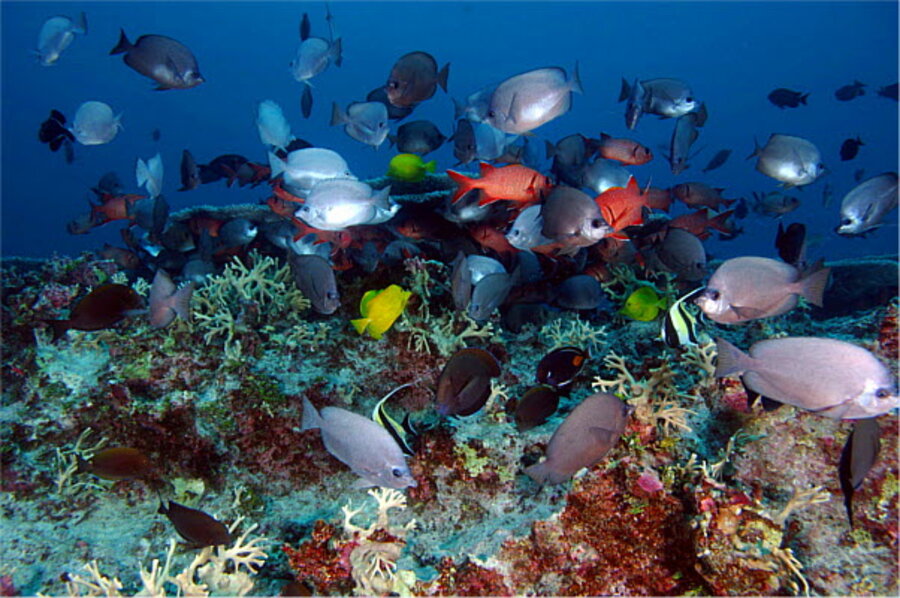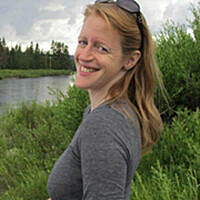Unexpected ally against future hurricanes: nature?
Loading...
Mother Nature might provide the best defense against rising sea levels and ever-larger hurricane storm surges, says a new study published in this week's "Nature: Climate Change."
Coastal habitats – especially if left intact – can protect vulnerable oceanfront land and the people who live there, says author Katie Arkema, a Seattle-based marine ecologist with the Natural Capital Project.
"The waves break on coral reefs or coastal forests, and therefore lose energy," says Mary Ruckelshaus, who works with Dr. Arkema at the Natural Capital Project, a partnership among Stanford University, The Nature Conservancy, the World Wildlife Fund, and the University of Minnesota. This strips the waves of their power to erode land, flood buildings, and wreak the havoc seen after storms like Sandy and Katrina. Other coastal habitats, like dunes and seagrasses, work in different ways, but they all "diffuse the energy in the waves, and reduce how much they can erode the shoreline," she adds.
The research team found that, today, 16 percent of the US coastline – home to 1.3 million people, including 250,000 elderly people and 30,000 families below the poverty line, not to mention over $300 billion in residential property value – is in a "high hazard" area. The research team created the first-ever map showing a level of hazard risk for every square kilometer of shoreline.
"The places that are at high risk of hazards like flooding and erosion, from sea-level rise and storms, are also those places where there are a lot of people and a lot of coastal infrastructure," says Dr. Arkema. And while the most valuable property has the wealthiest people, there are miles of shoreline inhabited by some of the poorest in the country, she notes.
In addition to examining the current risk, Arkema and her colleagues considered four different possibilities for the future, using current trends and predictions from the Intergovernmental Panel on Climate Change's Special Report on Emission Scenarios. Their future possibilities range from maintaining current patterns, to two "middle of the road" scenarios, to one that assumes that the Greenland ice sheet has melted, says Arkema.
If the "middle of the road" sea level rise takes place by the end of the century, the situation on the seashore will get 30 to 60 percent worse, the scientists calculated. Their model didn't include commercial property, or any increase in population or property value, so their figures – including half a trillion dollars of property damage – actually represent a massive underestimate of the probable risk from coastal hazards.
But there's hope.
Intact coral reefs, mangrove forests, and other coastal ecosystems can reduce both the likelihood and the magnitude of losses, they say. Recognizing this, the federal government passed the Coastal Barrier Resources Act (CBRA) in 1982, which ended federal subsidies for development or post-disaster rebuilding in over 3 million acres along the shore.
Right now, coastal habitats protect two thirds of the US coastline, found Arkema's team. Florida, New York, and California currently have the most people and property protected by coastal habitats, even though Alaska and North Carolina both have more coastline than either New York or California. In New York's Suffolk and Kings counties, coastal forests protect over $20 billion in residential property value.
"If we do nothing, those habitats are likely to be chipped away," says Dr. Ruckelshaus. If they're lost entirely, due to development pressures or pollution or climate change, the hazards could double, endangering another 1.4 million people currently living near the shore.
On the other hand, if reefs are restored, the shoreline can start to repair itself. Though this wasn't included in their article, which focused on the nation as a whole, Arkema and her team have begun using a more targeted version of their model to predict the effects of habitat restoration. In one project, in Mobile Bay, they helped select the location for a new oyster reef. "In photographs, we've already seen increased shoreline restoration right behind those oyster reefs, over quite a short time period," says Arkema.
How they mapped coastal hazards
First, scientists defined the "hazard risk" for every square kilometer of coast.
Not all shoreline environments are created equal, nor do they provide equal protection. Anything perched on a cliff overlooking the sea is less vulnerable to storm damage than people or property located on mud flats or gentle beaches, say the scientists. No surprise there.
But the offshore environment matters, too. Underwater coral reefs and semi-submerged mangrove or cypress forests can buffer land over a mile inland, they found, while seagrass beds and other underwater plants provide very little protection, and only for the quarter-mile closest to shore. Marshes, oyster reefs, sand dunes, and seaweed forests provide intermediate levels of protection.
Then, they translated "hazard risk" into the actual threat to human life and property by mapping out coastal populations, poor families, elderly people, and residential property values.
After all, the most expensive storms in US history weren't necessarily the biggest, but the ones that made landfall in areas with the highest property values. Similarly, the most deadly storms weren't the strongest, but those that hit places with low-income or elderly populations that couldn't evacuate easily.
And it's not just about property value, the scientists caution. "We know now why the lower Ninth got flooded in hurricane Katrina," says Ruckelshaus. "If they'd known to protect certain marshes, they could have protected the most economically vulnerable populations in New Orleans and Louisiana."
Decision-makers who look at this hazard map shouldn't limit their focus to property values, warn the researchers in their "Nature" letter, lest they "overlook ecosystems that provide disproportionate protection of vulnerable populations." Texas and Virginia, for example, each have more than a thousand low-income families on the coast, though neither state has more than $5 billion in vulnerable property value.
Finally, once they'd mapped out the hazards, the researchers tested their model against reality.
When they compared their model to hurricanes and other coastal disasters between 1995 and 2010, they found that their model predicted the scale of human fatalities and amount of property damage more than 99 percent of the time.
Then they looked into the future, examining likely storm damage over the next century with and without the protection from coral reefs, coastal forests, and other seashore ecosystems.
"Coastal ecosystems are critical to protecting lives and property at a national scale," says Arkema.








